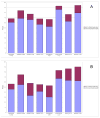Patterns of opioid utilization in pregnancy in a large cohort of commercial insurance beneficiaries in the United States
- PMID: 24525628
- PMCID: PMC3999216
- DOI: 10.1097/ALN.0000000000000172
Patterns of opioid utilization in pregnancy in a large cohort of commercial insurance beneficiaries in the United States
Abstract
Background: There are few data regarding the utilization of opioids during pregnancy. The objective of this study was to define the prevalence and patterns of opioid use in a large cohort of pregnant women who were commercial insurance beneficiaries.
Methods: Data for the study were derived from a deidentified research database of women from across the United States who had both medical and prescription benefits. By using diagnostic codes, the authors defined a cohort of 534,500 women with completed pregnancies who were enrolled in a commercial insurance plan from 6 months before pregnancy through delivery.
Results: Overall, 76,742 women (14.4%) were dispensed an opioid at some point during pregnancy. There were 30,566 women (5.7%) dispensed an opioid during the first trimester, 30,434 women (5.7%) during the second trimester, and 34,906 women (6.5%) during the third trimester. Of these, 11,747 women (2.2%) were dispensed opioids three or more times during pregnancy. The most commonly dispensed opioids during pregnancy were hydrocodone (6.8%), codeine (6.1%), and oxycodone (2.0%). The prevalence of exposure at anytime during pregnancy decreased slightly during the study period from 14.9% for pregnancies that delivered in 2005 to 12.9% in 2011. The prevalence of exposure varied significantly by region and was lowest in the Northeast and highest in the South.
Conclusions: This study demonstrates that opioids are very common exposures during pregnancy. Given the small and inconsistent body of literature on their safety in pregnancy, these findings suggest a need for research in this area.
Conflict of interest statement
Conflicts of interest: SHD has consulted for Novartis, GlaxoSmithKlein-Biologics (Middlesex, England, United Kingdom) and AstraZenaca (London, England, United Kingdom) and JS is a consultant to Optum Insight (Eden Prairie, Minnesota, United States of America) and World Health Information Science Consultants, LLC (Newton, Massachusetts, United States of America), both for unrelated projects. The other authors declare no potential conflict of interest.
Figures




Comment in
-
Balance in opioid prescription during pregnancy.Anesthesiology. 2014 May;120(5):1063-4. doi: 10.1097/ALN.0000000000000173. Anesthesiology. 2014. PMID: 24525629 Free PMC article. No abstract available.
References
-
- Parsells Kelly J, Cook SF, Kaufman DW, Anderson T, Rosenberg L, Mitchell AA. Prevalence and characteristics of opioid use in the US adult population. Pain. 2008;138:507–13. - PubMed
-
- Zerzan JT, Morden NE, Soumerai S, Ross-Degnan D, Roughead E, Zhang F, Simoni-Wastila L, Sullivan SD. Trends and geographic variation of opiate medication use in state Medicaid fee-for-service programs, 1996 to 2002. Med Care. 2006;44:1005–10. - PubMed
-
- Brixner DI, Oderda GM, Roland CL, Rublee DA. Opioid expenditures and utilization in the Medicaid system. J Pain Palliat Care Pharmacother. 2006;20:5–13. - PubMed
Publication types
MeSH terms
Substances
Grants and funding
LinkOut - more resources
Full Text Sources
Other Literature Sources
Medical

